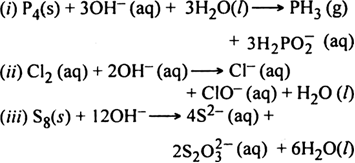 Short Answer Type
Short Answer TypeConsider the reactions:
(a) H3PO2(aq) + 4 AgNO3(aq) + 2 H2O(l) → H3PO4(aq) + 4Ag(s) + 4HNO3(aq)
(b) H3PO2(aq) + 2CuSO4(aq) + 2H2O(l) → H3PO4(aq) + 2Cu(s) + H2SO4(aq)
(c) C6H5CHO(l) + 2[Ag (NH3)2]+(aq) + 3OH–(aq) → C6H5COO–(aq)+ 2Ag(s) +4NH3 (aq) + 2H2O(l)
(d) C6H5CHO(l) + 2Cu2+(aq) + 5OH–(aq) → No change observed.
What inference do you draw about the behaviour of Ag+ and Cu2+ from these reactions ?
 Long Answer Type
Long Answer TypeDiscuss briefly the types of redox reactions. Give examples.
or
Discuss the following redox reactions.
(a) Combination reactions
(b) Decomposition reactions
(c) Displacement reactions
(d) Disproportionation reactions.
Give one example in each case.
Suggest a scheme of classification of the following redox reactions:
(a) N2(g) + O2(g) → 2 NO (g)
(b) 2Pb(NO3)2(s) → 2PbO(s) + 2 NO2 (g) + ½ O2 (g)
(c) NaH(s) + H2O(l) → NaOH(aq) + H2 (g)
(d)2NO2(g) + 2OH–(aq) → NO2-(aq) +NO3–(aq)+H2O(l)
 Short Answer Type
Short Answer TypeRefer to the periodic table given in your book and now answer the following questions:
(a) Select the possible non-metals that can show disproportionation reaction.
(b) Select three metals that can show disproportionation reaction.
In a disproportionation reaction, one of the reacting substances in a reaction always contains an element that can exist in at least three oxidation states.
(a) The non-metals such as P4,Cl2 and S8 show disproportionation reaction as indicated below:

 Long Answer Type
Long Answer Type Short Answer Type
Short Answer TypeWhat sorts of informations can you draw from the following reaction?
(CN)2(g) + 2OH– (aq) → CN–(aq) + CNO–(aq) + H2O(l)
Suggest a scheme of classification of the given redox reactions,
N2 (g) + O2 (g)  2NO (g)
2NO (g)
